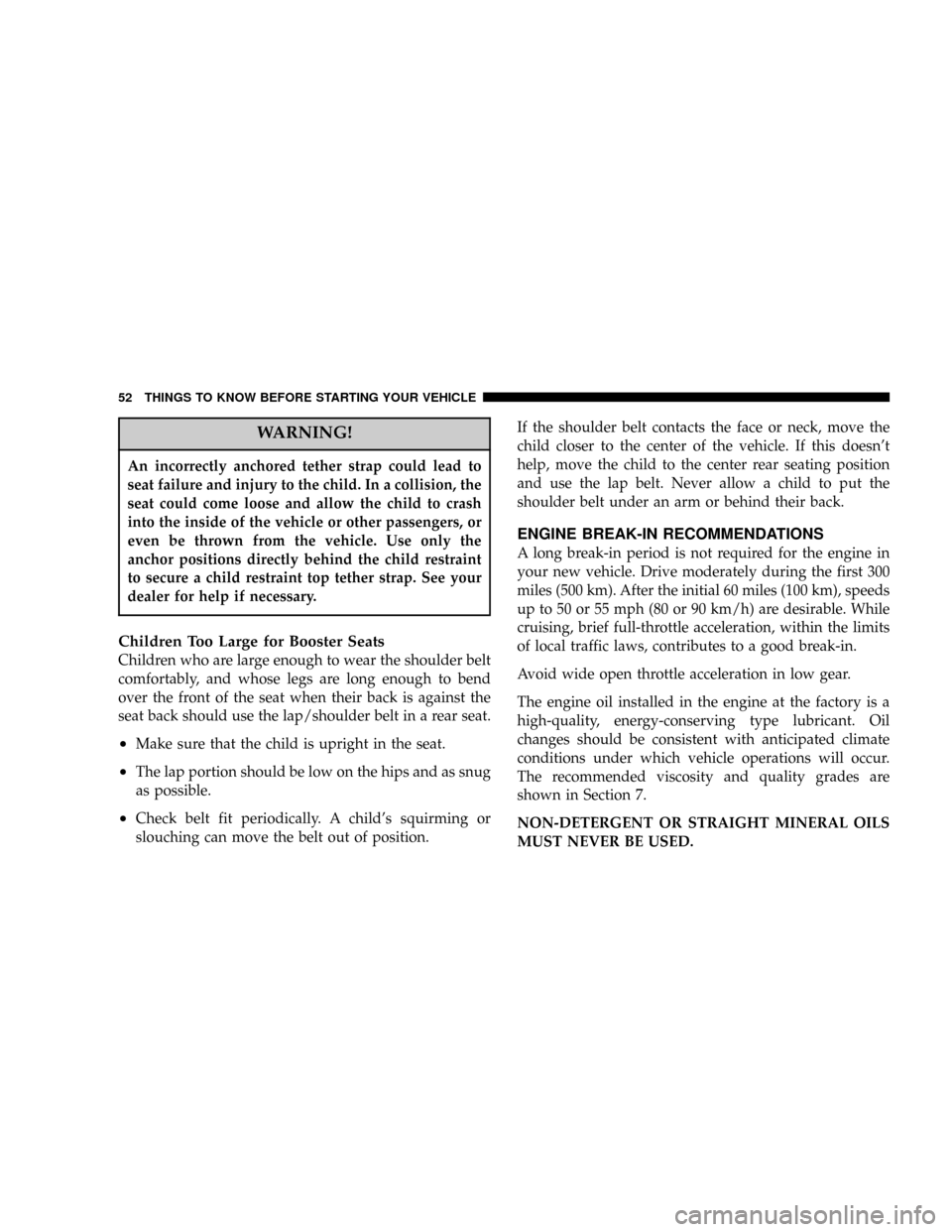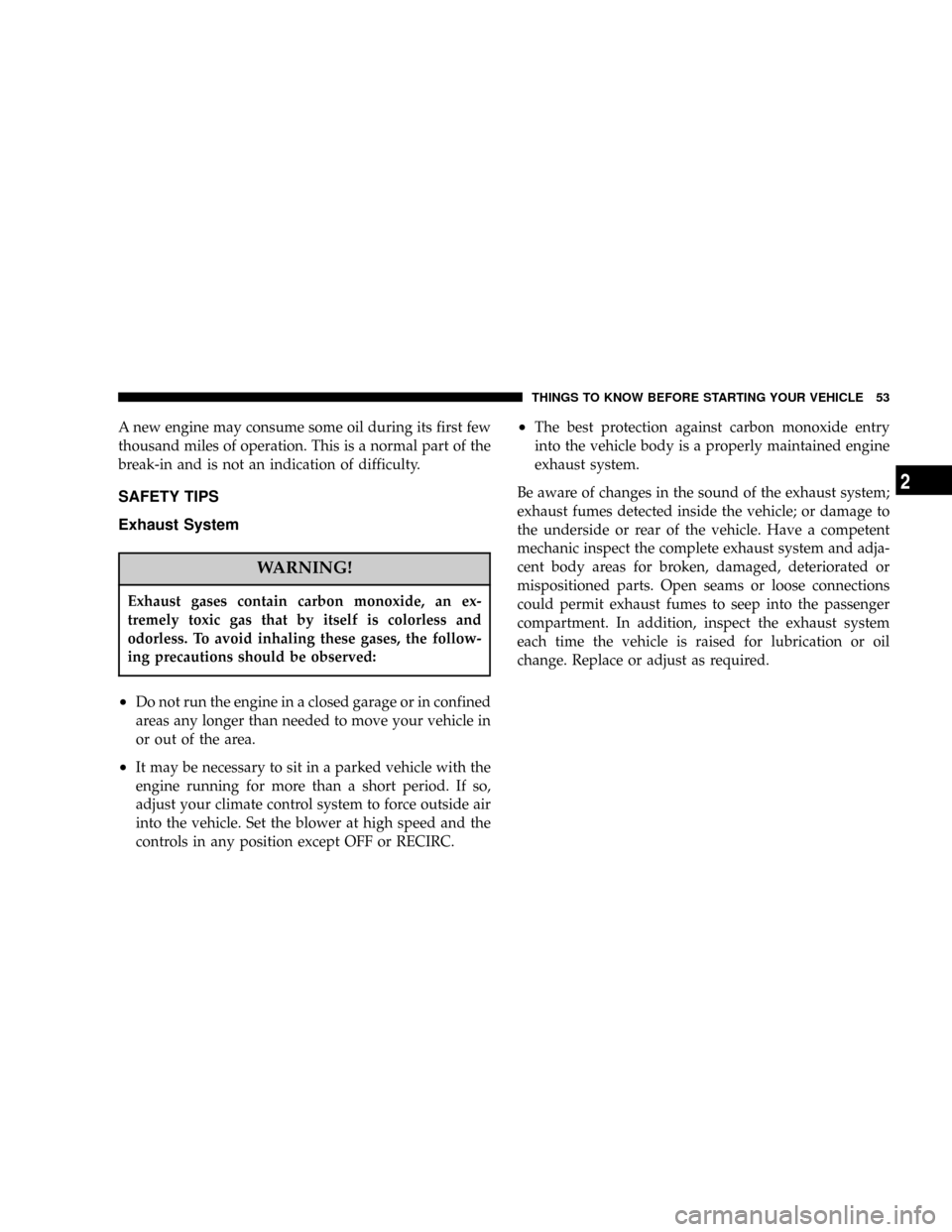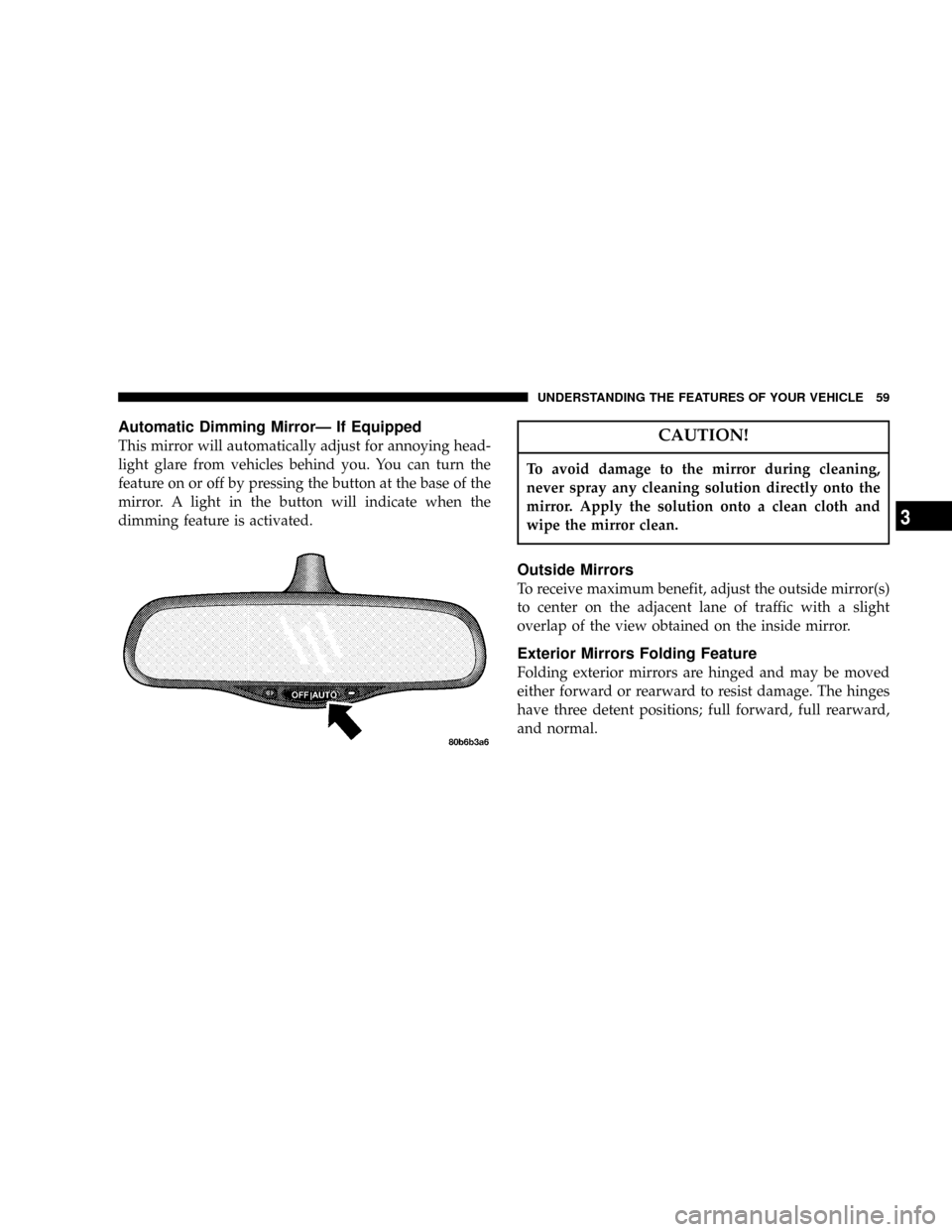DODGE DAKOTA 2004 3.G Workshop Manual
Manufacturer: DODGE, Model Year: 2004, Model line: DAKOTA, Model: DODGE DAKOTA 2004 3.GPages: 300, PDF Size: 5.23 MB
Page 51 of 300

Multiple Child Restraint
THINGS TO KNOW BEFORE STARTING YOUR VEHICLE 51
2
Page 52 of 300

WARNING!
An incorrectly anchored tether strap could lead to
seat failure and injury to the child. In a collision, the
seat could come loose and allow the child to crash
into the inside of the vehicle or other passengers, or
even be thrown from the vehicle. Use only the
anchor positions directly behind the child restraint
to secure a child restraint top tether strap. See your
dealer for help if necessary.
Children Too Large for Booster Seats
Children who are large enough to wear the shoulder belt
comfortably, and whose legs are long enough to bend
over the front of the seat when their back is against the
seat back should use the lap/shoulder belt in a rear seat.
²Make sure that the child is upright in the seat.
²The lap portion should be low on the hips and as snug
as possible.
²Check belt fit periodically. A child's squirming or
slouching can move the belt out of position.If the shoulder belt contacts the face or neck, move the
child closer to the center of the vehicle. If this doesn't
help, move the child to the center rear seating position
and use the lap belt. Never allow a child to put the
shoulder belt under an arm or behind their back.
ENGINE BREAK-IN RECOMMENDATIONS
A long break-in period is not required for the engine in
your new vehicle. Drive moderately during the first 300
miles (500 km). After the initial 60 miles (100 km), speeds
up to 50 or 55 mph (80 or 90 km/h) are desirable. While
cruising, brief full-throttle acceleration, within the limits
of local traffic laws, contributes to a good break-in.
Avoid wide open throttle acceleration in low gear.
The engine oil installed in the engine at the factory is a
high-quality, energy-conserving type lubricant. Oil
changes should be consistent with anticipated climate
conditions under which vehicle operations will occur.
The recommended viscosity and quality grades are
shown in Section 7.
NON-DETERGENT OR STRAIGHT MINERAL OILS
MUST NEVER BE USED.
52 THINGS TO KNOW BEFORE STARTING YOUR VEHICLE
Page 53 of 300

A new engine may consume some oil during its first few
thousand miles of operation. This is a normal part of the
break-in and is not an indication of difficulty.
SAFETY TIPS
Exhaust System
WARNING!
Exhaust gases contain carbon monoxide, an ex-
tremely toxic gas that by itself is colorless and
odorless. To avoid inhaling these gases, the follow-
ing precautions should be observed:
²Do not run the engine in a closed garage or in confined
areas any longer than needed to move your vehicle in
or out of the area.
²It may be necessary to sit in a parked vehicle with the
engine running for more than a short period. If so,
adjust your climate control system to force outside air
into the vehicle. Set the blower at high speed and the
controls in any position except OFF or RECIRC.
²The best protection against carbon monoxide entry
into the vehicle body is a properly maintained engine
exhaust system.
Be aware of changes in the sound of the exhaust system;
exhaust fumes detected inside the vehicle; or damage to
the underside or rear of the vehicle. Have a competent
mechanic inspect the complete exhaust system and adja-
cent body areas for broken, damaged, deteriorated or
mispositioned parts. Open seams or loose connections
could permit exhaust fumes to seep into the passenger
compartment. In addition, inspect the exhaust system
each time the vehicle is raised for lubrication or oil
change. Replace or adjust as required.
THINGS TO KNOW BEFORE STARTING YOUR VEHICLE 53
2
Page 54 of 300

Safety Checks You Should Make Inside The
Vehicle
Seat Belts
Inspect the belt system periodically, checking for cuts,
frays and loose parts. Damaged parts must be replaced
immediately. Do not disassemble or modify the system.
Seat belt assemblies must be replaced after an accident if
they have been damaged (bent retractor, torn webbing,
etc.). If there is any question regarding belt or retractor
condition, replace the belt.
Defrosters
Check operation by selecting the defrost mode and place
the blower control on high speed. You can feel the air
directed against the windshield.
Safety Checks You Should Make Outside The
Vehicle:
Tires
Examine tires for tread wear or uneven wear patterns.
Check for stones, nails, glass or other objects lodged in
the tread.
Inspect for tread cuts or sidewall cracks. Check wheel
nuts for tightness and tires for proper pressure.
Lights
Have someone observe the operation of exterior lights as
you turn them on. Check turn signal and high beam
indicator lights on the instrument panel.
Door Latches
Check for positive closing, latching and locking.
Fluid Leaks
Check the area under vehicle after overnight parking for
fuel, water, oil, or other fluid leaks. Also, if gasoline
fumes are detected, the cause should be located and
corrected.
54 THINGS TO KNOW BEFORE STARTING YOUR VEHICLE
Page 55 of 300

UNDERSTANDING THE FEATURES OF YOUR VEHICLE
CONTENTS
mMirrors..............................58
NInside Day/Night Mirror.................58
NAutomatic Dimming MirrorÐ If Equipped....59
NOutside Mirrors.......................59
NExterior Mirrors Folding Feature...........59
NElectric Remote-Control Mirrors............60
NHeated Mirrors Ð If Equipped.............61
mSeats................................61
NSeat Adjustment.......................61
NReclining Seats........................62
N6 - Way Power Seat Adjuster Ð Driver's Side
Only...............................63NLumbar Support Adjustment Ð Power Seats
Only...............................63
NSeatback Releases Ð Bench Seat............63
NSeatback ReleasesÐBucket And Split Bench....64
NClub Cab Easy Entry System..............64
NClub Cab/Quad Cab Rear Seat.............65
mTo Open And Close The Hood.............66
mLights...............................67
NInterior Lights........................67
NBattery Saver.........................68
NHeadlamp Delay.......................68
NHeadlights, Parking Lights, Panel Lights......68
3
Page 56 of 300

NDaytime Running Lights (Canada Only)......69
NLights-On Reminder....................69
NFog Lights Ð If Equipped................69
NCargo Light Ð If Equipped...............70
mMultifunction Control Lever...............70
NTurn Signals..........................70
NPassing Light.........................70
NHigh Beam / Low Beam Select Switch.......71
NWindshield Wipers.....................71
NWindshield Washers....................72
mTilt Steering Column Ð If Equipped.........73
mElectronic Speed Control Ð If Equipped......74
NTo Activate...........................74
NTo Set At A Desired Speed................74
NTo Deactivate.........................74
NTo Resume Speed......................75NTo Vary The Speed Setting................75
NTo Accelerate For Passing................75
mOverhead Console......................76
NCourtesy/Reading Lights.................76
mCompass/Temperature Mini-Trip Computer...77
NUS/M Button.........................77
NReset Button..........................77
NGlobal Reset..........................77
NStep Button..........................78
NAverage Fuel Economy (AVG ECO).........78
NDistance To Empty (DTE)................78
NTrip Odometer (ODO)...................78
NElapsed Time (ET)......................78
NC/T Button..........................79
NCompass/Temperature Display............79
NAutomatic Compass Calibration............79
56 UNDERSTANDING THE FEATURES OF YOUR VEHICLE
Page 57 of 300

NManual Compass Calibration..............80
NOutside Temperature....................81
mGarage Door Opener....................81
NProgramming Homelink.................82
NCanadian Programming/Gate Programming . . .84
NUsing Homelink.......................85
NErasing Homelink Buttons................85
NReprogramming a Single Homelink Button....85
NSecurity.............................85
mElectrical Power Outlets Ð If Equipped......86
NElectrical Outlet Use With Engine Off........87
mFloor Console Ð If Equipped..............88
NFloor Console Features..................88
mCenter Storage Compartment Ð If Equipped...89
mCup Holders..........................89
mTailgate..............................90
mSlide-In Campers.......................90
NCamper Applications....................90
NGeneral Information....................91
NCarbon Monoxide Warning Vehicles Equipped
With A Cap Or Slide-In Campers...........91
UNDERSTANDING THE FEATURES OF YOUR VEHICLE 57
3
Page 58 of 300

MIRRORS
Inside Day/Night Mirror
The mirror should be adjusted to center on the view
through the rear window. A two-point pivot system
allows for horizontal and vertical adjustment of the
mirror.Annoying headlight glare can be reduced by moving the
small control under the mirror to the night position
(toward rear of truck). The mirror should be adjusted
while set in the day position (toward windshield).
58 UNDERSTANDING THE FEATURES OF YOUR VEHICLE
Page 59 of 300

Automatic Dimming MirrorÐ If Equipped
This mirror will automatically adjust for annoying head-
light glare from vehicles behind you. You can turn the
feature on or off by pressing the button at the base of the
mirror. A light in the button will indicate when the
dimming feature is activated.CAUTION!
To avoid damage to the mirror during cleaning,
never spray any cleaning solution directly onto the
mirror. Apply the solution onto a clean cloth and
wipe the mirror clean.
Outside Mirrors
To receive maximum benefit, adjust the outside mirror(s)
to center on the adjacent lane of traffic with a slight
overlap of the view obtained on the inside mirror.
Exterior Mirrors Folding Feature
Folding exterior mirrors are hinged and may be moved
either forward or rearward to resist damage. The hinges
have three detent positions; full forward, full rearward,
and normal.
UNDERSTANDING THE FEATURES OF YOUR VEHICLE 59
3
Page 60 of 300

Electric Remote-Control Mirrors
The controls for the power mirrors are located on the
driver's door trim panel.Set the top switch to the left or right for the left or right
mirror, and set it to the center off position to prevent
accidentally moving a mirror when you are finished
adjusting the mirror. To adjust a mirror, select left or right
with the top switch, and press one of the four arrows for
the direction you want the mirror to move.
60 UNDERSTANDING THE FEATURES OF YOUR VEHICLE